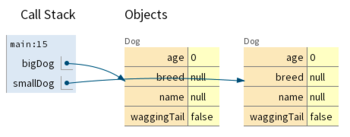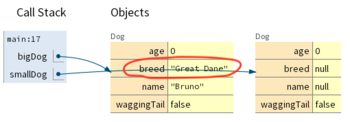- Use "dot notation" to access a field (instance variable) through an object reference
- Modify an object's state by assigning a new value to a field
- Use IntelliJ's Java Visualizer to view object state
In this lesson, we will learn how to change an object's state by using
Java's dot operator . to access a field through an object reference.
Let's create a new project and then add the Dog class.
Create a new Maven Java project named "object_state".
Right-click on the Java folder and create a new Java class named Dog.
Edit the Dog class and add the following code:
public class Dog {
String name;
String breed;
int age;
boolean waggingTail;
public static void main(String[] args) {
// create 2 Dog instances
Dog bigDog = new Dog();
Dog smallDog = new Dog();
}
}Let's continue with the Dog class and the main method that creates two Dog instances:
public class Dog {
String name;
String breed;
int age;
boolean waggingTail;
public static void main(String[] args) {
// create 2 Dog instances
Dog bigDog = new Dog();
Dog smallDog = new Dog();
}
}As we saw in the last lesson, the fields of each Dog instance are initialized to default values based on their data type:
But we would like to assign the fields with specific values as shown below:
Looking at the objects in memory, we can see there are two memory locations with the label name,
and two memory locations with the label breed, etc. How can we assign the name of the first
dog to "Bruno" and the name of the second dog to "Penny"?
The solution is to use syntax referred to as "dot notation". The dot operator . is
used to separate a variable that references an object and the name of a field. We can
assign a value to a field for a specific object using dot notation as shown below:
objectReference.fieldName = value
To assign the value "Bruno" as the name of the dog referenced by the variable bigDog, we write:
bigDog.name = "Bruno";
To assign the value "Penny" as the name of the dog referenced by the variable smallDog, we write:
smallDog.name = "Penny";
Let's update the main method to assign values to the fields of each dog
using the two object references bigDog and smallDog.
public class Dog {
String name;
String breed;
int age;
boolean waggingTail;
public static void main(String[] args) {
// create 2 Dog instances
Dog bigDog = new Dog();
Dog smallDog = new Dog();
// assign new values to the fields of the first dog
bigDog.name = "Bruno";
bigDog.breed = "Great Dane";
bigDog.age = 8;
// assign new values to the fields of the second dog
smallDog.name = "Penny";
smallDog.breed = "Pug";
smallDog.age = 5;
smallDog.waggingTail = true;
}
}Notice the main method does not assign a value to bigDog.waggingTail, so the field
retains the default boolean value false.
Executing the main method results in the desired object state:
Currently, the main method does not print anything, so it is hard to understand how the state changes as each
line of code is executed.
Let's step through the main method using the IntelliJ debugger and the Java Visualizer plugin, which
will let us see what the objects look like in memory.
Set a breakpoint on the first line of executable code in the main method (i.e. not a comment or blank line),
then click the "debug" icon to launch the debugger. Your line number may differ depending on comments and blank lines.
Select the "Java Visualizer" tab in the debug window.
Notice the call stack shows the main method has stopped at the breakpoint (your line number may be different).
Press the "Step Over" icon to execute each line of code in the main method.
Continue stepping through the code one line at a time and notice how the object state is updated.
NOTE: IntelliJ's Java Visualizer lays out the objects in a row, and unfortunately the arrows cross over the objects. If you want a column layout, use the browser based Java visualizer at https://pythontutor.com/java.html.
Sometimes Intellij's Java Visualizer plugin messes up how it displays the pointers from the object references.
Resizing the image using either the + or - button usually fixes the layout issue.
We can also use IntelliJ's default debugger and the "Variables" panel to see the state of each object as we step through code.
The process of setting a breakpoint and using the "Step Over" button to step through the code is the same as with the Java Visualizer.
Note that instead of using arrows, an object reference is displayed as a unique id such
as Dog@691 and Dog@693.
Assume the Bike class is defined as shown:
public class Bike {
String color;
int height;
public static void main(String[] args) {
Bike mountainBike = new Bike();
//change the color to red
????
}
}| Code | Java Visualizer |
|---|---|
Bike mountainBike = new Bike(); |
 |
| ???? |  |
What is the correct Java statement to assign the color of the bike to "red"?
Answer: mountainBike.color = "red";
Assume the ProgrammingLanguage class is defined as shown:
public class ProgrammingLanguage {
String name;
int yearReleased;
public static void main(String[] args) {
ProgrammingLanguage language1 = new ProgrammingLanguage();
ProgrammingLanguage language2 = new ProgrammingLanguage();
//assign values to fields
....
}
}Assume the main method has created two instances of ProgrammingLanguage and the statements
represented by .... have assigned the fields using the object references as shown:
What is the correct Java statement to assign the release year for the programming language named "Go" to 2007?
Answer: language2.yearReleased = 2007;
Each class instance has its own copy of the fields (instance variables).
We need to use an object reference and the dot operator . to access a field of a specific object.
We can modify an object's state by using dot notation to assign a new value to a field:
objectReference.fieldName = value


















